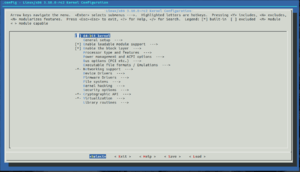menuconfig
|
menuconfig for a 3.10.0-rc2 Linux kernel | |
| Written in | C |
|---|---|
| Operating system | Linux |
| Type | build automation tool |
| License | GNU General Public License |
| Website |
www |
make menuconfig is one of five similar tools that can configure the Linux kernel source, a necessary early step needed to compile the source code. make menuconfig, with a menu-driven user interface, allows the user to choose the features of the Linux kernel (and other options) that will be compiled. It is normally invoked using the command make menuconfig, menuconfig is a target in the Linux kernel Makefile.
History
make menuconfig was not in the first version of the Linux kernel. The predecessor tool is a question-and-answer-based utility (make config, make oldconfig). A third tool for Linux configuration is make xconfig, which requires Qt. There is also make gconfig, which uses GTK+, and make nconfig, which is similar to make menuconfig.
Advantages over earlier versions
Despite being a simple design, make menuconfig offers considerable advantages to the question-and-answer-based configuration tool, the most notable being a basic search system and the ability to load and save files with filenames different from “.config”. make menuconfig gives the user an ability to navigate forwards or backwards directly between features, rather than using make config by pressing the ↵ Enter key up to 80 times to find a specific feature.
If the user is satisfied with a previous .config file, using make oldconfig uses this previous file to answer all questions that it can, only interactively presenting the new features. This is intended for a version upgrade, but may be appropriate at other times.
make menuconfig is a light load on system resources unlike make xconfig (uses Qt as of version 2.6.31.1, formerly Tk) or make gconfig, which utilizes GTK+. It's possible to ignore most of the features with make config, and doing so makes it more likely that one will configure an incomplete or oversized kernel. It's recommended to start with the .config file included with the Linux distribution, which makes it easier to configure a custom kernel.
Better than editing the .config by hand, make menuconfig shows the descriptions of each feature (?), and adds some (primitive in version 2.6.31.1) dependency checking. With make oldconfig, dependency checking can be done in one step, but requires the user to locate the features that were changed, by hand, to be sure that the needed ones are still enabled.
Practically, using both make menuconfig and make oldconfig, diff, (also cvs and a decent text editor) provides the most flexibility and most dependability. Configuring Linux is a significant labor, so users are strongly advised to make backups of it (i.e. cp /usr/src/linux*/.config ~/savemywork.config).
The help information is distributed throughout the kernel source tree in the various files called Kconfig.
Dependencies
To use make menuconfig, the Linux kernel source is a requirement, a make tool, a C compiler, and the ncurses library.
Key strokes
| Key stroke | Meaning |
|---|---|
| ? | Option description and tips/Help |
| ← → ↑ ↓ PgUp PgDn | Navigate through the kernel features and menuconfig commands. |
| Esc+Esc | Exit menuconfig or cancel the command. |
| ↵ Enter | Activate a command, or expand a branch. |
| y | Compile and include this feature inside of the kernel. |
| m | Compile this feature as a module, separate from the kernel. |
| n | Do not compile the feature. |
| / | Search configuration parameter. |
Symbols
To the left of the features is the setting (y, M, or empty) enclosed in two punctuation marks.
| Symbol | Meaning |
|---|---|
| < > | No dependencies. |
| [ ] | A dependency requires this to be compiled-in (y), or not compiled (n). |
| { } | A dependency requires this to be a module (m) or compiled-in (y). |
| - - | A dependency requires this to be compiled-in (y). |
Note that the supplied dependency information is primitive, it does not tell you the names of the depentant features.
| Symbol | Meaning |
|---|---|
| ---> | Use ↵ Enter to expand this branch as a new window. |
| (Experimental) | Less/Unstable code, beware. |
| (New) | An option not in an old version of Linux. |
What to do next
The user is encouraged to read the Linux README, since there are also many other targets. Each will configure the kernel, but with different features activated.
-
make menuconfig - Next build the compressed kernel and its modules, a long process.
make. - Install using your favorite method such as
make modules_install,make install.
See also
References
External links
| Wikibooks has a book on the topic of: Linux kernel |
| Wikibooks has a book on the topic of: Inside Linux Kernel |
| Wikimedia Commons has media related to Menuconfig. |
